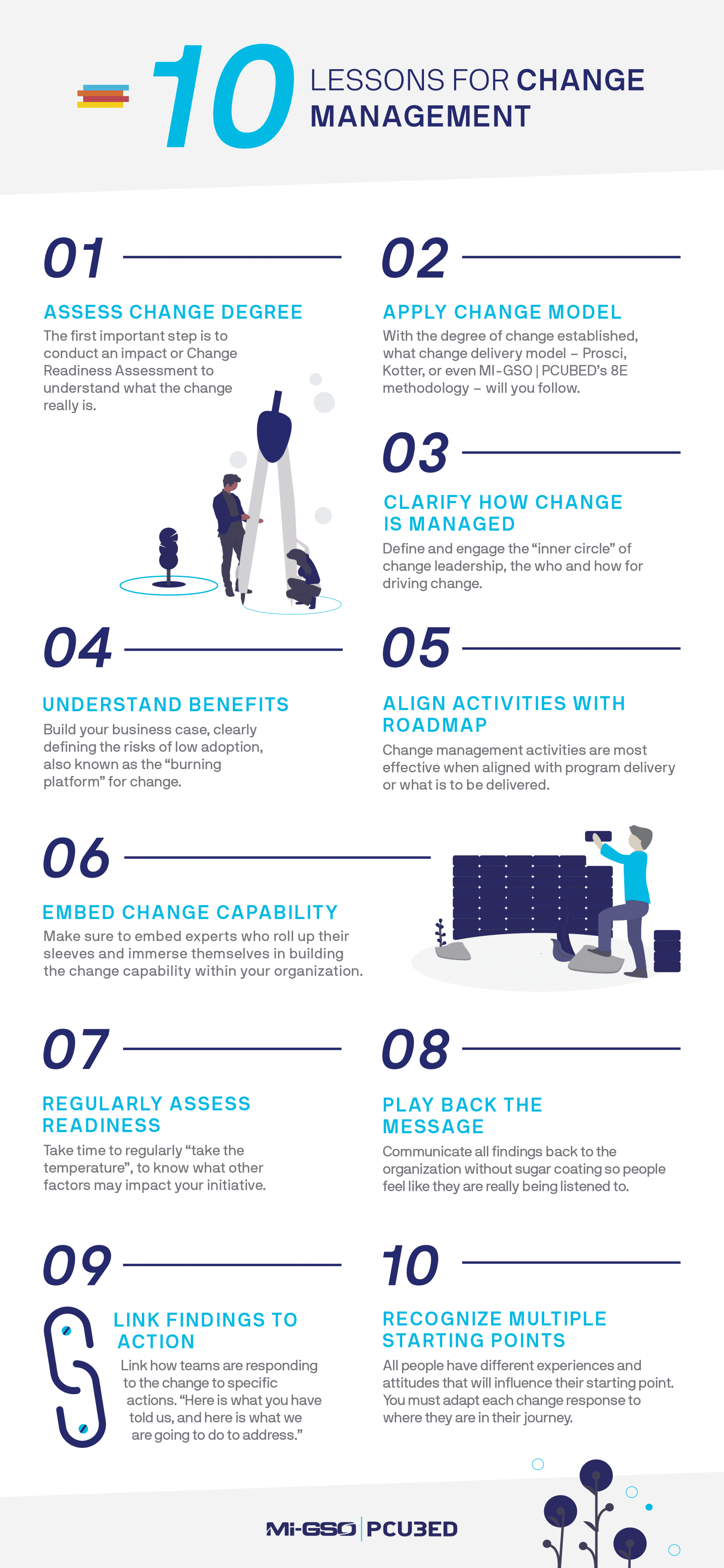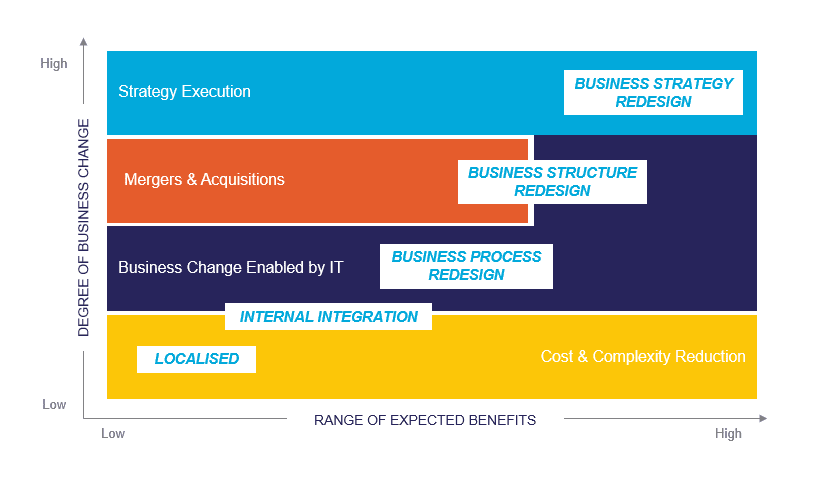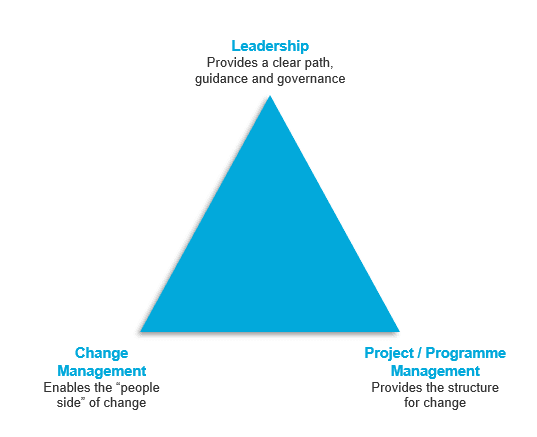Our website is not supported on this browser
The browser you are using (Internet Explorer) cannot display our content.
Please come back on a more recent browser to have the best experience possible

Change management is a discipline used across industries and geographies to ensure the adoption of change. Whether driven by pursuit of competitive capability, revenue growth, new market share, regulatory changes or something else; getting people on board for change is the most important determinant of success. Yet, without stakeholder support, any initiative you are introducing will be worth very little. Here we introduce our “lessons learned” while applying Change Management to help you in your future projects.
What lessons have you learned managing change? Find out how to manage stakeholders, who has influence on change, and why not to rush the Change Management process.
Research amongst 2,500 managers found that at least 30% of any performance increase could be attributed to an effective change management approach. In large projects, return on investment was 6.5 times higher where an effective change management approach was in place. In fact, respondents saw an average return of €6.80 for every €1 spent on change management.
There is a direct correlation between change effectiveness and the gap between benefits expected and benefits delivered. Even an incremental investment in change management up front can generate accelerated success at the back end of a project.

However, the discipline of change management still hasn’t gained widespread support among executive leadership. Key reasons include: not understanding the benefits, lack of trained resources for implementing, mistaking change management as a skill that project managers have, and “change” budget an easy target during cost-cutting.
MIGSO-PCUBED has compiled this list of “lessons learned” to help you get the mileage you are seeking out of your change management efforts. It also serves to act as a reminder of the activities to go through as you manage and communicate with your stakeholders.
More on the same subject

The first important step is to figure out what the change actually is. What is the level or degree of change that you are trying to manage within the business. That requires conducting an impact or Change Readiness assessment to understand the level of change to be supported.
As the following diagram shows, the process calls for a measurement of two dimensions. One is the expected benefits. The delivery of a new application to a small division, for example, would be on the low end of expected benefits. The other dimension examines the degree of business change.

As the type of change being introduced grows in cost and complexity, the higher will be the scope of change. Communications, training and other aspects of change management require different strategies at each level based on the type of change at stake, so its important to know what you are up against up front.
Once the degree of change is established, you need to determine what change delivery model to follow. There are a number of solid disciplines out there: Kotter, Prosci, the Darwin Wheel of Change, and so on.
Your job will be to choose a model that works for your organization. You will need to stick with it in order to be able to reliably measure people’s status along the change spectrum.
Where are their hearts and minds? Do they believe in the project or program? Are they moving forward? Are they likely to use the new asset being delivered?
The project or program can proceed if all leaders pivotal to the success of the change are engaged, a change team exists with sufficient business representation, a clear and concise vision for the future has been developed and shared and an assessment has shown suitable preparedness throughout the business.
Once the organization understands the degree of change and has a change model in place, it is time to define and engage the “inner circle” of change leadership and the wider change team. This speaks to governance: Who is going to drive the change at each level?
If the change is taking place across an organization, senior leadership should be providing a clear path for communications. They will need to deliver the messages and “walk the talk” so that people know to take the change activities seriously. The project and program management teams will provide the structure for change.

However, what we also propose is the addition of the change management team itself to facilitate the “people” aspects of change. This is the third prong in the diagram above.
Alongside the core change management team, it is useful also to look at appointing “change agents” in the organization. Change agents are engaged advocates of the change who can help embed the change in their respective areas.
Change management is not an alternative to strong project and program management. It is to be carried out in conjunction with other management activities, creating an environment where the changes introduced add the highest value and help maximize benefits. We have found that the most successful business transformations leverage all three of these components.
Once the governance structure is set up, it is time to build the business case for change. The change management discipline continually needs to describe back to the business what benefits they are going to receive as a result of the work and investment being made.
Often, business benefits are described in terms of the technology being delivered or benefits on a business-wide level. Those terms will not necessarily resonate with people in the business community.
In the surveys and open forums used as part of your change readiness assessments, people will use a certain vocabulary to describe the kind of changes they are or will be undergoing. One effective technique, we have found, is to use that same verbiage when describing the business benefits back to those same stakeholders.
One effective technique, we have found, is to use that same verbiage when describing the business benefits back to those same stakeholders.
They really want to hear about simplifying administrative processes, improving sales, customer service or something comparable. Articulating the real benefits for them rather than for the business.
The program team leads a large project or program by identifying what is to be delivered, scoping out the work, delivering it and then closing it out.
Change management activities are most effective when they fit within the stages of that journey. MIGSO-PCUBED recognizes this, and so the 8E Change Delivery Model is fully aligned with the overarching program delivery methodology that we use.
In the early phases, you are identifying stakeholders and creating that shared vision of the future. As you go out and talk, you’re not going to have all the answers, so you need to create a message that explains that with honesty.
“I would like you to be involved in this. We don’t know all the answers yet. We’re trying to define the scope. So come and participate.”
As you approach delivery, the message will revolve around assurances that the work is ongoing. That you want stakeholders to be involved in those activities.
“We’re working on it. We’re building the project based on your requirements. Come and help us test it.”
As the project goes into delivery and closure, the message will emphasize the need to bring in early adopters.
“We are seeking people to use the new resource and become advocates. We need people who can talk with colleagues about the benefits and help get people moving in the right direction.”
A major challenge of change management is that it is a relatively new discipline, particularly for large programs. Your change managers need to be effective in several areas including:
Underlying this entire skill set is communication. The ability to connect with various stakeholder groups and the savvy to understand what form of messaging is useful when.
Additional Change Management tools are available to help you in our dedicated article.
As you move through the change journey you will need to take time to regularly assess the status of change readiness. Change Readiness is not static. You will need to take the organization’s “temperature,” in order to understand what the climate is for receiving the new asset or process.
It is also important to find out what other factors may influence program delivery. For example, the team of people most affected by the new resource may have other activities pressuring them during that same time that it is being deployed.
Once the change readiness assessment is done, communicate the findings of the survey back to the business leaders. You should communicate this to your audiences without sugarcoating or over-simplifying the results.
It is important as a change management team to play back exactly what you hear. To get people more willing to be involved, they need to feel like they are being listened to.
They need to recognize their own words in the terms you use in communicating with them; otherwise, they may not believe that you really understand their challenges.
Once you have derived the findings regarding how people are feeling and responding to the change initiative, it is time to link those findings to specific actions and make appropriate changes.
“Here is what you have told us. Here is what we believe that means. And, here is what we are doing to address that gap, problem or concern.”
As hard as it is sometimes, you need to learn to value those individuals who are most vocal in their objections. These are the people most willing to tell you whether something is going to work or not.
Quite often project people will try to ignore objections. They believe that once the change is underway, participants will more readily understand why it was needed. In our experience it does not often work that way.
Lesson learned from client experience: Test the new IT asset and processes with the people who will be using them. Listen to the ones who are “shouting”. Respond by adapting the processes as needed and communicating back to them how it is you are responding.
The people who will be using the new asset or process, for the most part, are highly skilled and motivated to come into work on a daily basis. They do a good job, though with different experiences, attitudes and cultural backgrounds.
Introducing a change to that imperils their goal. So you also need to recognize that as you move them into the new business process or new way of working, they will approach it in unique ways and from different perspectives.
Each individual may require a different style of training or a different form of messaging. This is so that they can individually understand what is coming and what is expected of him or her.
As you survey or interview them, you will be able to determine if they find the new asset concerning or frustrating. You will also be able to see where they are in the spectrum of change readiness. Whether they are ready to jump in and try it out, or not.
MIGSO-PCUBED has worked with hundreds of clients in locations around the world to help facilitate the organizational, cultural and people changes needed for successful business change programs.
As you build out your project or program plans, we hope that you are persuaded about the value of integrating change management into the work that you are undertaking and can learn from our lessons. But if you should need any additional tips, we are ready to jump in.
This article was originally
written by David Winters.
Loved what you just read?
Let's stay in touch.
No spam, only great things to read in our newsletter.
We combine our expertise with a fine knowledge of the industry to deliver high-value project management services.
MIGSO-PCUBED is part of the ALTEN group.
Find us around the world
Australia – Canada – France – Germany – Italy – Mexico – The Netherlands – Portugal – Romania – South East Asia – Spain – Switzerland – United Kingdom – United States
© 2024 MIGSO-PCUBED. All rights reserved | Legal information | Privacy Policy | Cookie Settings | Intranet
Perfect jobs also result from great environments : the team, its culture and energy.
So tell us more about you : who you are, your project, your ambitions,
and let’s find your next step together.
Dear candidates, please note that you will only be contacted via email from the following domain: migso-pcubed.com. Please remain vigilant and ensure that you interact exclusively with our official websites. The MIGSO-PCUBED Team
Choose your language
Our website is not supported on this browser
The browser you are using (Internet Explorer) cannot display our content.
Please come back on a more recent browser to have the best experience possible
